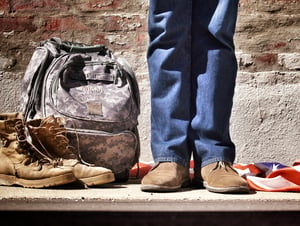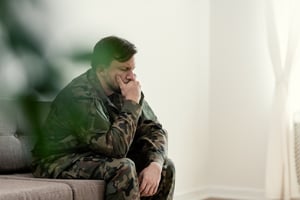A blog post by Melissa Ruisz Nazario

Called Armistice Day or Remembrance Day in other countries, we originally commemorated November 11th because of the signing of the treaty that halted fighting during World War I. Today, known as Veterans Day in the U.S., the focus has shifted a bit, as we show respect and gratitude to those who previously served in our armed forces. We often associate the words “service” and “sacrifice” with being in the military because a mission’s success requires things that aren’t as common in the civilian world: working twelve-hour shifts for months while deployed thousands of miles away from loved ones, missing important birthdays and holidays, and for many, having to put one’s self in harm’s way in a combat zone, risking life and mental wellness.
While post-traumatic stress disorder (PTSD) is not exclusive to the military and can affect anyone who has experienced any type of trauma, veterans experience a higher rate of PTSD than the general population.[1] Yet, veterans often seek help less frequently because they don’t want to be seen as weak or be treated differently.[2] Additionally, some military leaders also believe that the term "disorder" makes suffering service members averse to seeking help, and they've tried to have it renamed post-traumatic stress injury, which would help reduce the stigma associated with "disorder."[3]
 Understanding PTSD
Understanding PTSD
The Diagnostic and Statistical Manual of Mental Disorders (DSM-5) categorizes PTSD as a trauma- and stressor-related disorder triggered by exposure to actual or threatened death, serious injury, or sexual violation, and the disturbance causes significant distress and impairment of an individual's daily life and interactions.[4] Some symptoms include persistent re-experiencing of the traumatic events, whether through flashbacks or dreams, difficulty sleeping, avoidance of anything that reminds the sufferer of trauma, negative changes in thoughts, feelings, or perceptions related to the trauma, and changes in reactivity, such as angry outbursts.[5]
Wounded Warriors, Initiated Warriors
One depth psychological perspective, however, interprets the wounds from war and combat as an initiation into a lifelong warrior's journey. As Bonnie Bright, Ph.D., describes in "Tending Soul with Military, Veterans, and First Responders," based on an interview with Ed Tick, Ph.D., and John Becknell, Ph.D., the warrior journey is psycho-mythic, "a psycho-spiritual passage that allows a warrior to carry the pain and suffering they have observed while in service without falling victim to
As the article explains, the Warrior archetype is engaged within those who are dedicated to preserving and protecting society. While it has existed in myth, sacred writings, and societies for thousands of years, the difference in modern society is that the military does not help their warriors to complete the initiation process of the warrior's journey, so that they "can come home and carry the experience with meaning, honor, dignity, and without suffering personal psychological or spiritual distress or devastation due to what they have experienced in the field."
Tick and Becknell consider the wounding as a cosmic, life-changing, even transformative experience, and urge that society in general refrain from judging those that have experienced this wounding and reframe their perspectives beyond the binary "
A Soldier’s Story: Trauma, Trickster and Transcendence
Earlier this year, Craig E. Stephenson, Ph.D., presented "A Soldier’s Story: Trauma, Trickster and Transcendence" at Pacifica's Trauma + Transcendence Conference. He discussed one of The Brothers Grimm's
In his talk, he connects the Grimms’ narrative to current issues about PTSD and
"What in wartime was his power and his pride, is now in peacetime something that alienates him from the human society he served so fearlessly," Stephenson says about the tale Bearskin, as he draws connections to today's military returning from combat. "Wherever he goes, people flee him, repulsed by his identification with the bearskin. The Brothers Grimm's revised tale speaks to a two-sided problem in their time. There is the question of the fearlessness of the soldier, of what to make of a wild, warring spirit in peacetime, and there is the concomitant shadow question of his brothers' hardheartedness."
Watch the entire presentation here:
Resources for Veterans
Veterans suffering from PTSD and in a crisis have at least three options for getting immediate help:
- Call the Veterans Crisis Line at 1-800-273-8255 and
pressing 1
- Start a confidential chat online with the Crisis Chat at https://www.veteranscrisisline.net/get-help/chat
- Call 911

Aside from talking with loved ones or a professional mental health provider, there are several resources for dealing with PTSD symptoms. The National Center for PTSD’s article, “Coping with Traumatic Stress Reactions,” explains coping, and specifically active coping. Active coping is “accepting the impact of trauma on your life and taking direct action to improve things,” but also lists several tools and strategies for specific PTSD symptoms, such as sudden feelings of anxiety or panic, feeling irritable or angry, and dealing with difficulty falling or staying asleep as well as nightmares related to the trauma.[7]
Peer support groups are a way for those suffering to meet others who share the same experiences and allow them to feel that they're not alone. The Anxiety and Depression Association of America has an option to search for support groups.[8] The National Alliance on Mental Illness also can help with finding local support groups.[9]
Another form of actively coping is practicing mindfulness. This involves not only becoming more aware of the present
For those unsure about the efficacy or what's involved with seeking and receiving therapy for PTSD, an online resource called AboutFace provides educational information as well as videos of veterans, family members, and clinicians sharing their stories and experiences with PTSD and PTSD treatment.[12]
 Resources for Mental Health Care Providers
Resources for Mental Health Care Providers
For providers and practitioners concerned with helping service members and veterans with PTSD, there are several resources available. For example, they can take free courses about trauma and PTSD through the National Center for PTSD while also receiving continuing education credit. Course titles include “Aging and PTSD,” “Posttraumatic Stress Disorder and Reintegration Challenges,” and “Military Culture: Core Competencies for Healthcare Professionals,” among many others. Check out the entire course catalog here: https://www.ptsd.va.gov/professional/continuing_ed/index.asp
Professionals can also stay abreast of the latest trauma research and its applications through the National Center for PTSD’s Electronic Publications page: https://www.ptsd.va.gov/publications/electronic_pubs.asp On this page, there are also several different PTSD-related email lists that practitioners can subscribe
Also, Proquest has articles related to PTSD, and even a specific PTSD-related index of articles called “PTSDPubs.” https://search.proquest.com/ptsdpubs/index
Depth Psychological Resources
In "Trauma and PTSD collected info, commentary
Pacifica Post also has several resources on
In a summary of Donald Kalsched's opening keynote presentation, "The Core Complex of a Traumatized Psyche," for the event Response at the Radical Edge: Depth Psychology for the 21st Century, Bonnie Bright describes Kalsched's model of the dissociating psyche and "various unconscious archetypal powers arranged in a dynamic system of defense that attempts to protect a sacred, innocent psyche from further violation."
Bonnie Bright also interviewed several researchers, professors, and psychotherapists who work in the field of trauma and who presented at the Trauma + Transcendence Conference hosted by Pacifica Graduate Institute earlier this year. Links to those audio interviews and summary blog posts can be found in this roundup article: https://www.pacificapost.com/conversations-on-trauma-transcendence-roundup
Several videos of the presentations from the 2018 Trauma + Transcendence Conference are now available on our YouTube channel.
Pacifica Graduate Institute will be offering a Trauma Studies Certificate Program starting September 2019 for therapists, clinicians, those in helping professions, and those with a committed interest in deepening their understanding of trauma. This professional training will feature several renowned depth psychotherapists and thought leaders in the field of trauma. Find details about all the presenters and sessions, and register for this groundbreaking training here: https://retreat.pacifica.edu/trauma-studies/
Additionally, on November 5, 2019, The Retreat at Pacifica Graduate Institute will be offering the online course "The Trauma of Everyday Life: Perspectives from Buddhism and Psychotherapy" presented by Michael Epstein, M.D., a practicing Buddhist, psychiatrist, and Clinical Assistant Professor in the Postdoctoral Program in Psychotherapy and Psychoanalysis at New York University. The event is open to the public, and you can register here: https://retreat.pacifica.edu/trauma-of-everyday-life/

Conclusion
Nicole Fisher says in “The Facts that Matter Most on Veterans Day” that “our deepest gratitude and unparalleled respect for the men and women who keep us safe often fails at repaying them in the ways they need it most when they return. This Veterans Day, as we say thank you, let’s ensure that we have a better understanding of the difficult mental and physical health issues that millions of our veterans face each day."[14]
While Veterans Day is a holiday to remember and express gratitude for our military members’ service and sacrifices, it should go beyond that. Perhaps we can also take
Note: This post is provided for informational purposes only.
[1] https://www.healthyplace.com/ptsd-and-stress-disorders/ptsd/ptsd-statistics-and-facts
[2] https://www.healthyplace.com/ptsd-and-stress-disorders/ptsd/effects-of-ptsd-on-military-veterans
[3] https://www.psychiatry.org/File%20Library/.../Practice/DSM/APA_DSM-5-PTSD.pdf
[4] https://www.psychiatry.org/File%20Library/.../Practice/DSM/APA_DSM-5-PTSD.pdf
[5] https://www.healthyplace.com/ptsd-and-stress-disorders/ptsd/effects-of-ptsd-on-military-veterans
[7] https://www.ptsd.va.gov/gethelp/coping_stress_reactions.asp
[8] https://adaa.org/supportgroups
[9] https://www.nami.org/Find-Support
[10] https://www.ptsd.va.gov/gethelp/mindfulness_tx.asp
[11] https://www.ptsd.va.gov/appvid/mobile/mindfulcoach_app.asp
[12] https://www.ptsd.va.gov/apps/aboutface/
[13] https://beyondmeds.com/2012/10/10/trauma-infographic/

Melissa



